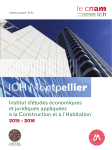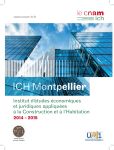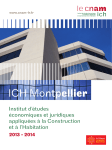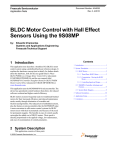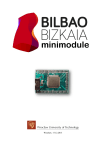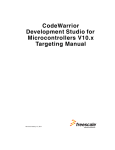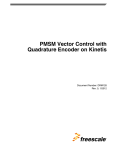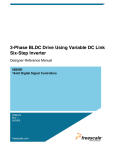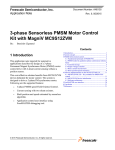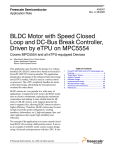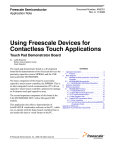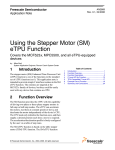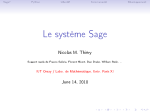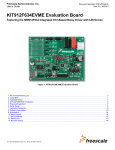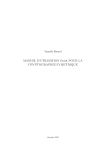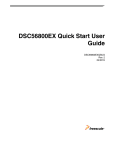Download 3-Phase AC Induction Motor Control with PFC
Transcript
3-Phase AC Induction Motor Control with PFC Using MC9S08MP16 Design Reference Manual Devices Supported: MC9S08MP16 Document Number: DRM115 Rev. 0 11/2009 How to Reach Us: Home Page: www.freescale.com E-mail: [email protected] USA/Europe or Locations Not Listed: Freescale Semiconductor Technical Information Center, CH370 1300 N. Alma School Road Chandler, Arizona 85224 +1-800-521-6274 or +1-480-768-2130 [email protected] Europe, Middle East, and Africa: Freescale Halbleiter Deutschland GmbH Technical Information Center Schatzbogen 7 81829 Muenchen, Germany +44 1296 380 456 (English) +46 8 52200080 (English) +49 89 92103 559 (German) +33 1 69 35 48 48 (French) [email protected] Japan: Freescale Semiconductor Japan Ltd. Headquarters ARCO Tower 15F 1-8-1, Shimo-Meguro, Meguro-ku, Tokyo 153-0064, Japan 0120 191014 or +81 3 5437 9125 [email protected] Asia/Pacific: Freescale Semiconductor China Ltd. Exchange Building 23F No. 118 Jianguo Road Chaoyang District Beijing 100022 China +86 10 5879 8000 [email protected] For Literature Requests Only: Freescale Semiconductor Literature Distribution Center 1-800-441-2447 or 303-675-2140 Fax: 303-675-2150 [email protected] Information in this document is provided solely to enable system and software implementers to use Freescale Semiconductor products. There are no express or implied copyright licenses granted hereunder to design or fabricate any integrated circuits or integrated circuits based on the information in this document. Freescale Semiconductor reserves the right to make changes without further notice to any products herein. Freescale Semiconductor makes no warranty, representation or guarantee regarding the suitability of its products for any particular purpose, nor does Freescale Semiconductor assume any liability arising out of the application or use of any product or circuit, and specifically disclaims any and all liability, including without limitation consequential or incidental damages. “Typical” parameters that may be provided in Freescale Semiconductor data sheets and/or specifications can and do vary in different applications and actual performance may vary over time. All operating parameters, including “Typicals”, must be validated for each customer application by customer’s technical experts. Freescale Semiconductor does not convey any license under its patent rights nor the rights of others. Freescale Semiconductor products are not designed, intended, or authorized for use as components in systems intended for surgical implant into the body, or other applications intended to support or sustain life, or for any other application in which the failure of the Freescale Semiconductor product could create a situation where personal injury or death may occur. Should Buyer purchase or use Freescale Semiconductor products for any such unintended or unauthorized application, Buyer shall indemnify and hold Freescale Semiconductor and its officers, employees, subsidiaries, affiliates, and distributors harmless against all claims, costs, damages, and expenses, and reasonable attorney fees arising out of, directly or indirectly, any claim of personal injury or death associated with such unintended or unauthorized use, even if such claim alleges that Freescale Semiconductor was negligent regarding the design or manufacture of the part. Freescale™ and the Freescale logo are trademarks of Freescale Semiconductor, Inc. The ARM POWERED logo is a registered trademark of ARM Limited. ARM7TDMI-S is a trademark of ARM Limited. Java and all other Java-based marks are trademarks or registered trademarks of Sun Microsystems, Inc. in the U.S. and other countries. The PowerPC name is a trademark of IBM Corp. and is used under license.The described product contains a PowerPC processor core. The PowerPC name is a trademark of IBM Corp. and used under license. The described product is a PowerPC microprocessor. The PowerPC name is a trademark of IBM Corp. and is used under license. The described product is a PowerPC microprocessor core. The PowerPC name is a trademark of IBM Corp. and is used under license. All other product or service names are the property of their respective owners. © Freescale Semiconductor, Inc. 2008. All rights reserved. DRM115 Rev. 0 11/2009 Chapter 1 Introduction 1.1 1.2 1.3 Introduction . . . . . . . . . . . . . . . . . . . . . . . . . . . . . . . . . . . . . . . . . . . . . . . . . . . . . . . . . . . .1 1.1.1 Application Features and Components . . . . . . . . . . . . . . . . . . . . . . . . . . . . . . . . .1 1.1.2 Overview of Variable Speed Drives . . . . . . . . . . . . . . . . . . . . . . . . . . . . . . . . . . .2 Freescale Controller Advantages and Features . . . . . . . . . . . . . . . . . . . . . . . . . . . . . . . .3 1.2.1 Peripheral Application Usage . . . . . . . . . . . . . . . . . . . . . . . . . . . . . . . . . . . . . . . .4 Bibliography . . . . . . . . . . . . . . . . . . . . . . . . . . . . . . . . . . . . . . . . . . . . . . . . . . . . . . . . . . . .6 1.3.1 Acronyms and Abbreviations . . . . . . . . . . . . . . . . . . . . . . . . . . . . . . . . . . . . . . . .6 1.3.2 Glossary of Symbols . . . . . . . . . . . . . . . . . . . . . . . . . . . . . . . . . . . . . . . . . . . . . . .7 Chapter 2 Control Theory 2.1 2.2 2.3 2.4 2.5 3-Phase AC Induction Motor . . . . . . . . . . . . . . . . . . . . . . . . . . . . . . . . . . . . . . . . . . . . . . .1 AC Induction Motor Scalar Control . . . . . . . . . . . . . . . . . . . . . . . . . . . . . . . . . . . . . . . . . .3 2.2.1 Volts-per-Hertz Control . . . . . . . . . . . . . . . . . . . . . . . . . . . . . . . . . . . . . . . . . . . . .4 2.2.2 Constant Slip Control . . . . . . . . . . . . . . . . . . . . . . . . . . . . . . . . . . . . . . . . . . . . . .5 2.2.3 Open-Loop Startup . . . . . . . . . . . . . . . . . . . . . . . . . . . . . . . . . . . . . . . . . . . . . . . .7 2.2.4 Digital Control of an AC Induction Motor . . . . . . . . . . . . . . . . . . . . . . . . . . . . . . .7 Speed Sensing Using AC Tacho Generator . . . . . . . . . . . . . . . . . . . . . . . . . . . . . . . . . . .8 Power Factor Correction Control . . . . . . . . . . . . . . . . . . . . . . . . . . . . . . . . . . . . . . . . . . . .9 2.4.1 PFC Critical Conduction Mode Implementation . . . . . . . . . . . . . . . . . . . . . . . . . 10 Current Sensing — Flex Timer and ADC Synchronization . . . . . . . . . . . . . . . . . . . . . . . 12 Chapter 3 System Concept 3.1 3.2 Application Description . . . . . . . . . . . . . . . . . . . . . . . . . . . . . . . . . . . . . . . . . . . . . . . . . . .1 Control Process . . . . . . . . . . . . . . . . . . . . . . . . . . . . . . . . . . . . . . . . . . . . . . . . . . . . . . . . .1 Chapter 4 Hardware 4.1 4.2 4.3 4.4 4.5 Hardware Implementation . . . . . . . . . . . . . . . . . . . . . . . . . . . . . . . . . . . . . . . . . . . . . . . . .1 MC9S08MP16 Daughter Board for UHV Power Stage . . . . . . . . . . . . . . . . . . . . . . . . . . .2 3-Phase Universal High Voltage Power Stage . . . . . . . . . . . . . . . . . . . . . . . . . . . . . . . . . .3 PFC Board . . . . . . . . . . . . . . . . . . . . . . . . . . . . . . . . . . . . . . . . . . . . . . . . . . . . . . . . . . . . .6 Motor Specifications — Example . . . . . . . . . . . . . . . . . . . . . . . . . . . . . . . . . . . . . . . . . . . .7 3-Phase AC Induction Motor Control with PFC Using MC9S08MP16, Rev. 3 Freescale Semiconductor 1 Chapter 5 Software Design 5.1 5.2 5.3 5.4 5.5 5.6 5.7 5.8 Introduction . . . . . . . . . . . . . . . . . . . . . . . . . . . . . . . . . . . . . . . . . . . . . . . . . . . . . . . . . . . .1 Main Software Flowchart . . . . . . . . . . . . . . . . . . . . . . . . . . . . . . . . . . . . . . . . . . . . . . . . . .1 Application Overview . . . . . . . . . . . . . . . . . . . . . . . . . . . . . . . . . . . . . . . . . . . . . . . . . . . . .2 Software States . . . . . . . . . . . . . . . . . . . . . . . . . . . . . . . . . . . . . . . . . . . . . . . . . . . . . . . . .3 5.4.1 Initialization . . . . . . . . . . . . . . . . . . . . . . . . . . . . . . . . . . . . . . . . . . . . . . . . . . . . . .5 5.4.2 Application Background Loop . . . . . . . . . . . . . . . . . . . . . . . . . . . . . . . . . . . . . . . .6 5.4.3 Interrupts . . . . . . . . . . . . . . . . . . . . . . . . . . . . . . . . . . . . . . . . . . . . . . . . . . . . . . .6 5.4.4 Library Functions . . . . . . . . . . . . . . . . . . . . . . . . . . . . . . . . . . . . . . . . . . . . . . . . .8 FreeMASTER Software . . . . . . . . . . . . . . . . . . . . . . . . . . . . . . . . . . . . . . . . . . . . . . . . . . .8 5.5.1 FreeMASTER Serial Communication Driver . . . . . . . . . . . . . . . . . . . . . . . . . . . . .9 5.5.2 FreeMASTER Recorder . . . . . . . . . . . . . . . . . . . . . . . . . . . . . . . . . . . . . . . . . . . 10 5.5.3 FreeMASTER Control Page . . . . . . . . . . . . . . . . . . . . . . . . . . . . . . . . . . . . . . . . 10 Setting the Software Parameters for a Specific Motor . . . . . . . . . . . . . . . . . . . . . . . . . . . 11 Microcontroller Memory Usage . . . . . . . . . . . . . . . . . . . . . . . . . . . . . . . . . . . . . . . . . . . . 12 Conclusion . . . . . . . . . . . . . . . . . . . . . . . . . . . . . . . . . . . . . . . . . . . . . . . . . . . . . . . . . . . . 12 3-Phase AC Induction Motor Control with PFC Using MC9S08MP16, Rev. 3 2 Freescale Semiconductor Chapter 1 Introduction 1.1 Introduction This document describes the cost-effective design of a three-phase AC induction motor, V/Hz and CSC (constant slip control) closed-loop speed control, and digital power factor correction (PFC) using the MC9S08MP16. The design is targeted at consumer and industrial applications. This cost-effective solution benefits from the dedicated motor control features in the Freescale Semiconductor MC9S08MP16 device. 1.1.1 Application Features and Components The system is designed to drive a three-phase AC induction motor. The application features: • Targeted at the MC9S08MP16 8-bit microcontroller. • Three-phase ACIM control using tacho generator as a rotary transducer. — Two control algorithms incorporating (optionally set from FreeMASTER). – V/Hz closed speed loop. – Constant (optimal) slip control in nominal speed range. — Controlled acceleration and deceleration. — Bidirectional rotation. — Both motor and generator modes. — PWM frequency 16 kHz. — Operation in FreeMASTER or demo operating mode. — Software over-voltage and under-voltage protection. — Hardware over-current protection. • Power Factor Correction (PFC). — Automatic input voltage detection 110 V/60 Hz and 230 V/50 Hz. — DC-bus voltage regulation: 390 V DC, 5% ripple for Pout = 300 W. — Over voltage protection. — Power factor: > 0.94 @ 230 V AC. • Three-phase high-voltage (230/115 V) power board. • High-voltage daughter controller board. • PFC board with input filter. • FreeMASTER software control interface (motor start/stop, speed setup). 3-Phase AC Induction Motor Control with PFC Using MC9S08MP16, Rev. 0 Freescale Semiconductor 1 Introduction • FreeMASTER software monitor. — FreeMASTER software graphical control page (required speed, actual motor speed, start/stop status, DC-bus voltage level, motor current, system status). — FreeMASTER software speed scope (actual and desired speeds, DC-bus voltage, and motor current). Figure 1-1. 3-Phase AC Motor Control with V/Hz CSC Speed Close Loop and PFC using MC9S08MP16 The main application components available for customers are: • Software — written in C-code using some library algorithms available for the HCS08. • Hardware — based on the Freescale universal motor-control hardware modules. • Documentation — this document. 1.1.2 Overview of Variable Speed Drives The design of cost-effective variable-speed 3-phase motor control drives has become a prime focus point for the appliance designers and semiconductor suppliers. Replacing variable-speed universal motors by maintenance-free, low-noise asynchronous (induction) motors is a trend that supposes total system costs being equivalent. The big push in this direction is given by several factors: • The new IEC555-1, European Community regulations dealing with electrical noise in power distribution. • Lines and low power consumption. • The flexibility that can be achieved in using asynchronous motors with variable frequency. 3-Phase AC Induction Motor Control with PFC Using MC9S08MP16, Rev. 0 2 Freescale Semiconductor Introduction • • • The maturity level and affordable price trend of power devices. The system efficiency optimization that microprocessor-controlled drives can provide. The size, weight, and dissipated power reduction of the motors for a given mechanical power. Most usual variable speed ac induction motor drive designs contain a full-bridge rectifier and a large DC-bus capacitor at the input. Such a circuit draws a peak current from the wall socket, which provokes a high content of harmonics. The low-power factor (PF), as described in the present circuit, reduces the necessary power from the mains and increases the efficiency of the mains supply network. The international standard IEC1000-3-2 defines the limits of the harmonic content of the input current for mains-supplied equipment. To meet the norms, the design requires a power factor correction at the input. The present design allows simultaneous driving of the power factor correction algorithm and the AC induction motor. This way, significant cost reductions of the design can be achieved. Moreover, a wide range of input voltages from 90 V to 265 V AC and regulation of DC-bus voltage can be achieved. Another benefit of the design is the possibility of an easy modification of the system by software updates.Two key requirements of the described design are that it has to be cost-effective and highly reliable. This design reference manual describes the basic motor theory, system design concept, hardware implementation, and software design, including the FreeMASTER software visualization tool. 1.2 Freescale Controller Advantages and Features The MC9S08MP16 is a member of the low-cost, high-performance HCS08 Family of 8-bit microcontroller units (MCUs). All MCUs in this family use the enhanced HCS08 core and are available with a variety of modules, memory sizes, memory types, and package types. The Freescale MC9S08MP16 microcontroller is well-suited for digital motor control offering many dedicated peripherals, such as Flextimer (FTM) modules, analog-to-digital converters (ADC), timers, communications peripherals (SCI, SPI, I2C), and onboard flash and RAM. The MC9S08MP16 device provides the following features: • Two Flextimer modules with a total of eight channels. • One analog-to-digital converter (ADC) 13-channel, 12-bit resolution, 2.5 µs conversion time. • One 8-bit modulo counter with an 8-bit prescaler and overflow interrupt. • Interrupt Priority Controller (IPC) with four programmable interrupt priority levels. • One differential Programmable Gain Amplifier (PGA) with programmable gain (x1, x2, x4, x8, x16, or x32). • Three fast analog comparators (HSCMP1, HSCMP2, and HSCMP3) with both positive and negative inputs. • Three 5-bit digital-to-analog converters (DAC) used as a 32 tap voltage reference. • Two programmable delay blocks (PDB). PDB1 synchronizes the PWM with samples of the ADC, PDB2 synchronizes the PWM with comparing window of analog comparators, PWM output synchronizes with FTM PWM output. • One serial peripheral interface (SPI). • One serial communications interface (SCI) with LIN slave functionality. 3-Phase AC Induction Motor Control with PFC Using MC9S08MP16, Rev. 0 Freescale Semiconductor 3 Introduction • • • • • • • • 1.2.1 One inter-integrated circuit (I2C) port. Onboard 3.3 V to 2.5 V voltage regulator for powering internal logic and memories. Integrated power-on reset and low-voltage interrupt module. Multiplexing of all pins with general-purpose input/output (GPIO) pins. Computer-operating-properly (COP) watchdog timer External reset input pin for hardware reset Single-wire background debug interface (BDM). Internal Clock Source (ICS) — Containing a frequency-locked-loop (FLL) controlled by internal or external reference. Peripheral Application Usage The ACIM V/Hz and CSC with PFC benefits greatly from the flexible PWM module, fast ADC, high-speed comparators HSCMP, program delay block PDB, and modulo timer MTIM. The Flex Timer offers flexibility in its configuration, enabling efficient three-phase motor control. Each FTM module supports an initialization trigger function which is used to trigger both PDBs. The FTM1 (Flex Timer module) features used in the application: • Input capture mode for tacho period signal measurement. • HSCMP output connected to the FTM1 input. The FTM2 (Flex Timer module) features used in the application: • Generation of six PWM signals. • Set combine mode with complementary outputs. • Dead time inserted. • Fault protection enabled for external over-current fault trigger. • Synchronized PWM register update on timer-overflow event. • Hardware trigger generation for ADC synchronization with the PWM signal (optional feature, not required for application functionality). The ADC features used in the application: • Hardware trigger for the ADC start generated by the PDB1. • Linear successive approximation algorithm with 12-bit resolution. • High-speed conversion. • 5 MHz module clock. The PDB1 (Program delay block) features used in the application (optional, not required): • The controllable delay from the Flextimer module’s SYNC output to the sample trigger input of the programmable gain amplifiers and ADC. 3-Phase AC Induction Motor Control with PFC Using MC9S08MP16, Rev. 0 4 Freescale Semiconductor Introduction The PDB2 features used in the application: • Single-shot mode, • Output PWM PFC pulse generation with precisely controlled rising and falling times, • Both hardware and software triggering. The HSCMP1 (High-speed comparator) features used in the application: • Input current zero-cross detection for PFC, • Compare level set by the DAC1, • Inversion on comparator output, • Output used for hardware trigger. The HSCMP2 features used in the application: • Comparator of tacho signal, • Compare level set by DAC2, • Output used for period measurement. The HSCMP3 features used in the application: • Input low voltage level detection, • Compare level set by DAC3. The DACx features used in the application: • Set compare level for each HSCCMPx. The MTIM (Modulo timer) features used in the application: • 8-bit modulo limit running, • Set time base for a 1 ms loop, • Overflow interrupt generation. 3-Phase AC Induction Motor Control with PFC Using MC9S08MP16, Rev. 0 Freescale Semiconductor 5 Introduction 1.3 Bibliography 1. 3-Phase Universal High Voltage Power Stage User’s Manual, Freescale Semiconductor, 2009 2. MC9S08MP16 Daughter Board for UHV Power Stage User’s Manual, Freescale Semiconductor, 2009 3. PFC Board User’s Manual, Freescale Semiconductor, 2009 4. MC9S08MP16 Reference Manual, Freescale Semiconductor, 2008 5. Code Warrior Development Studio for Freescale Microcontrollers V6.2, Freescale Semiconductor, 2008 6. AN2395 — PC Master Software Usage, Freescale Semiconductor, 2002 7. 3-Phase PM Synchronous Motor Vector Control, AN1931, by Prokop L., Grasblum P., 2005 8. Embedded Software Library for S08 User’s Manual, Freescale Semiconductor, 2009 For a current list of documentation, refer to www.freescale.com. 1.3.1 Acronyms and Abbreviations Table 1-1 contains sample acronyms and abbreviations used in a document. Table 1-1. Acronyms and Abbreviated Terms Term Meaning AC Alternating current ACIM AC Induction Motor ADC Analog-to-digital converter BDM Background Debug Mode COP Computer Operating Properly (watchdog timer) CSC Constant Slip Control DT GPIO I/O LED Dead time: a short time that must be inserted between the turning off of one transistor in the inverter half bridge and turning on of the complementary transistor, due to the limited switching speed of the transistors General-purpose input/output Input/output interfaces between a computer system and the external world — a CPU reads an input to sense the level of an external signal and writes to an output to change the level of an external signal Light-emitting diode MC9S08MP16 A Freescale family of HCS08 dedicated to motor control PFC Power Factor Correction PLL Phase-locked loop: a clock generator circuit in which a voltage-controlled oscillator produces an oscillation that is synchronized to a reference signal PWM Pulse-width modulation RPM Revolutions per minute 3-Phase AC Induction Motor Control with PFC Using MC9S08MP16, Rev. 0 6 Freescale Semiconductor Introduction Table 1-1. Acronyms and Abbreviated Terms (continued) Term Meaning SCI Serial communication interface module: a module that supports asynchronous communication V/Hz Volts per Hertz 1.3.2 Glossary of Symbols Table 1-2 shows a glossary of symbols used in this document. Table 1-2. Glossary of Symbols Term Definition ns synchronous stator speed fs synchronous stator frequency pp stator pole-pair number p stator pole number ωslip relative angular velocity ωs flux wave velocity ωr mechanical angular velocity 3-Phase AC Induction Motor Control with PFC Using MC9S08MP16, Rev. 0 Freescale Semiconductor 7 Introduction 3-Phase AC Induction Motor Control with PFC Using MC9S08MP16, Rev. 0 8 Freescale Semiconductor Chapter 2 Control Theory 2.1 3-Phase AC Induction Motor The AC induction motor is a rotating electric machine designed to operate from a 3-phase source of alternating voltage. For variable speed drives, the source is normally an inverter that uses power switches to produce approximately sinusoidal voltages and currents of controllable magnitude and frequency. The stator is supplied by a balanced three-phase AC power source. The synchronous speed of the motor (ns) is given by 2 × 60 × π × f n s = -----------------------------------s p [rpm] Eqn. 2-1 where fs is the synchronous stator frequency in Hz, and p is a stator pole number. A cross-section of a two-pole induction motor is shown in Figure 2-1. Slots in the inner periphery of the stator accommodate the 3-phase windings a,b,c. The turns in each winding are distributed so that the current in the stator winding produces an approximately sinusoidally-distributed flux density around the periphery of the air gap. When the three currents that are sinusoidally varying in time, but displaced in phase by 120° from each other, flow through the three symmetrically-placed windings, a radially-directed air gap flux density is produced that is also sinusoidally distributed around the gap, and rotates at an angular velocity equal to the angular frequency of the stator currents. The most common type of an induction motor has a squirrel cage rotor in which aluminum conductors or bars are cast into the slots in the outer periphery of the rotor. These conductors or bars are shorted together at both ends of the rotor by cast aluminum end rings, which also can be shaped to act as fans. In larger induction motors, copper or copper-alloy bars are used to fabricate the rotor cage winding. 3-Phase AC Induction Motor Control with PFC Using MC9S08MP16, Rev. 0 Freescale Semiconductor 1 Control Theory Stator Rotor b c' w a' a c b' Figure 2-1. PM Synchronous Motor — Cross Section As the sinusoidally-distributed flux density wave produced by the stator magnetizing currents sweeps past the rotor conductors, it generates voltage in them. The result is a sinusoidally-distributed set of currents in the short-circuited rotor bars. Because of the low resistance of these shorted bars, only a small relative angular velocity between the angular velocity of the flux wave (ωs) and the mechanical angular velocity (ω) of the two-pole rotor is required to produce the necessary rotor current. The relative angular velocity is called the slip velocity (ωslip). ω slip = ω s – ω r [rad.s-1] Eqn. 2-2 The interaction of the sinusoidally-distributed air gap flux density and induced rotor currents produces a torque in the rotor. The typical induction motor speed-torque characteristic is shown in Figure 2-2. 3-Phase AC Induction Motor Control with PFC Using MC9S08MP16, Rev. 0 2 Freescale Semiconductor Control Theory Figure 2-2. AC Induction Motor Speed-Torque Characteristic Squirrel-cage AC induction motors are popular because of their simple construction, low cost per horsepower and low maintenance (they contain no brushes, as do DC motors). They are available in a wide range of power ratings. With field-oriented vector control methods, AC induction motors can fully replace the standard DC motors, even in high-performance applications. 2.2 AC Induction Motor Scalar Control Two speed-control algorithms are incorporated in the presented application — Volts per Hertz and Constant Slip Control. The user can choose one of them using either definitions in the source code (located at the beginning of the main.c file) or the FreeMASTER control page. Both control methods are described in the following chapters. 3-Phase AC Induction Motor Control with PFC Using MC9S08MP16, Rev. 0 Freescale Semiconductor 3 Control Theory 2.2.1 Volts-per-Hertz Control The Volts-per-Hertz control method is the most popular method of Scalar Control which controls the magnitude of variables such as frequency, voltage, or current. The command and feedback signals are DC quantities that are proportional to the respective variables. A simple open-loop Volts/Hertz speed control for an induction motor is the control technique targeted at low-cost, low-performance drives. This basic scheme is unsatisfactory for more demanding applications where torque control is required. This drawback can be partly compensated for by implementing a closed-loop speed control with a speed sensor as a feedback quantity. This scheme is defined as a Volts-per-Hertz control because the voltage applied command is calculated directly from the applied frequency in order to maintain the air-gap flux of the machine constant. In a steady state operation, if it is assumed that there is a negligible voltage drop across the stator resistor, the machine air-gap flux is approximately proportional to the ratio Vs/fs, where Vs is the amplitude of a motor phase voltage and fs is the synchronous electrical frequency applied to the motor. However, when the frequency and voltage are low, the voltage drop across the stator resistance cannot be neglected and has to be compensated for. The control system is illustrated in Figure 2-3. The characteristic is defined by the base point (usually 50 Hz or 60 Hz) of the motor. Below the base point, the motor operates at optimum excitation, called constant torque operation, because of the constant Vs/fs ratio. Above this point, the motor operates under-excited, called constant power operation, because of the rated voltage limit. Since the air-gap flux is a maintained constant (constant Vs/fs ratio), independent of the applied synchronous electrical frequency, the torque produced depends on the slip frequency only. Thus, regulating the slip frequency, the torque and speed of the ACIM can be controlled with the constant V/Hz technique. Figure 2-3. Volts-per-Hertz Control Method Unfortunately, the Volts-per-Hertz ramp is designed for nominal motor / load conditions. If the conditions are not nominal, the motor does not work at the optimal level and the performance and efficiency are bad. The optimal slip-control algorithm resolves such disadvantages. 3-Phase AC Induction Motor Control with PFC Using MC9S08MP16, Rev. 0 4 Freescale Semiconductor Control Theory 2.2.2 Constant Slip Control From motor-control theory, it is known that a slip frequency exists when the motor efficiency is at its highest. Close to that slip frequency there is another where the phase current is at its lowest — this means that the inverter losses are the lowest. The compromise between these two parameters is the constant (optimal) slip frequency when the system efficiency is the best. This optimal slip frequency significantly depends neither on electrical sine frequency nor the motor load. The optimal slip frequency can be determined by the drive efficiency measurement or by a calculation. To control a drive with high efficiency, this feature is applied. The system concept of a constant slip speed closed loop control is shown in Figure 2-4. MC9S08MP16 Speed Command FreeMASTER Speed Ramp Required Speed + Voltage Amplitude V/Hz Sine PWM Generation Max. Voltage + Integrator U V W Phase + Fault Processing Optimal Slip Actual Speed Speed Calculation Tacho Signal Figure 2-4. Control Concept The speed closed loop control is characterized by the measurement of the actual motor speed. This value is compared with the reference value (required speed as an output of the speed ramp), and the error signal is generated. The magnitude and polarity of the error signal corresponds to the difference between the actual and required speed. The PI controller generates stator voltage amplitude value, based on the speed error, in order to compensate the error. A 3-phase motor is supplied with sinusoidal voltage wave generated by the PWM unit (FTM2) of the microcontroller. The parameters are the frequency phase and the voltage amplitude. Control algorithm calls one of the control modes depending on motor conditions: • Amplitude < 100% — VOLTAGE CONTROL, see Figure 2-5 — The frequency is calculated as the sum of the actual speed and the optimal slip frequency (4 Hz for the tested drive). — The voltage is adapted according to the load using a PI controller. It means that for different loads the amplitude of the supply voltage differs. 3-Phase AC Induction Motor Control with PFC Using MC9S08MP16, Rev. 0 Freescale Semiconductor 5 Control Theory PWM's Speed Command Speed Ramp Required Speed + Error Amplitude PI Controller + Sine PWM Generation Output Sine Frequency Sine phase Integrator + Actual Motor Speed Optimal Slip Figure 2-5. Voltage Control Concept • Amplitude reaches 100% — FREQUENCY CONTROL, see Figure 2-6 — For higher speeds and heavy loads, when the amplitude given by the PI output reaches the maximum value, it is necessary to increase the slip of the motor in order to achieve the desired speed. — The output voltage amplitude is a maintained constant — maximal. — The machine transits to the field-weakening region. In this region the efficiency of the drive is decreased due to the slip increase. PWM's Amplitude = AMPLITUDE_MAX Speed Command Speed Ramp Required Speed + Error PI Controller Sine PWM Generation Output Sine Frequency Sine phase Integrator Actual Motor Speed Figure 2-6. Frequency Control Concept In the case of an inertial load, the motor can work like a generator during deceleration. In opposite to a simple V/Hz drive, the generator mode must be detected and the control algorithm adapted. The control error of the PI controller E(n) has to be calculated differently. The generator region is sensed using following condition: IF (Actual rotor frequency > Generated stator frequency) THEN => generator region ELSE => motor region 3-Phase AC Induction Motor Control with PFC Using MC9S08MP16, Rev. 0 6 Freescale Semiconductor Control Theory In the MOTOR region the control error E(n) is calculated as follows: Error = RequiredSpeed – ActualSpeed In the GENERATOR region the control error E(n) is calculated as follows: Error = ActualSpeed – (RequiredSpeed + 2 x OptimalSlip) The rest of the control strategy is the same for both motor and generator regions. 2.2.3 Open-Loop Startup The application utilizes an open-loop startup from zero up to the minimal measurable rotor speed. The generated tacho voltage is proportional to motor rotation, and it generates an incomparable voltage signal from a zero speed up to the minimal measurable rotor speed (see 2.3, “Speed Sensing Using AC Tacho Generator”). Because of this speed sensor drawback during the motor startup, the actual tacho speed is set to a minimal measurable speed which enables generating a speed error for the PI controller. When the rotor speed can be sensed, the speed control loop is closed. 2.2.4 Digital Control of an AC Induction Motor In adjustable speed applications, AC motors are powered by inverters. The inverter converts a DC power to an AC power at the required frequency and amplitude. Figure 2-7 illustrates a typical 3-phase inverter. + DC-Bus C + - DC-Bus Ph. B Ph. A Ph. C 3-Phase AC Motor Figure 2-7. Power Stage Schematic Diagram The inverter consists of three half-bridge units where the upper and lower switches are controlled complementarily, meaning when the upper one is turned on, the lower one must be turned off, and vice versa. Because the power device’s turn-off time is longer than its turn-on time, some dead time must be inserted between turning off one transistor of the half-bridge, and turning on its complementary device. The output voltage is mostly created by a pulse width modulation (PWM) technique. The 3-phase voltage waves are shifted 120° to each another, thus a 3-phase motor can be supplied. 3-Phase AC Induction Motor Control with PFC Using MC9S08MP16, Rev. 0 Freescale Semiconductor 7 Control Theory 2.3 Speed Sensing Using AC Tacho Generator A tacho generator is a precision shaft-mounted generator used to sense mechanical speed of motor rotation. It generates an AC voltage which is highly linear in proportion to the actual motor speed and is used as a feedback signal required for a speed control loop.The precision of speed measurement depends on the tacho generator pole-pair number. In the application, the 8-pole-pair tacho generator is used. This generates eight periods of sinusoidal signal per each mechanical revolution. The biggest problem of using a tacho as a motor speed transducer is that it does not work at zero and low speed operations which have to be compensated for by software. The actual speed is calculated in the 10 ms loop. As a comparator, the on-chip HSCMP2 (High Speed Comparator) is used. The analog signal is limited to 3.3 V and connected to HSCMP2 positive input P1. The compared value is set by the internal DAC2 and connected to HCSCMP2 minus input M4. The comparator output is internally connected to the FTM1 input and, using a capture event, the period between the two comparator signal edges is obtained. The actual motor speed is then evaluated from the captured tacho period. System configuration is shown in Figure 2-8. MC9S08MP16 HSCMP2 FTM1 Passive ACIM Capture Input Input M4 Tacho period Output Filter Input Input P1 DAC2 Clk System clock / 8 Output Figure 2-8. Tacho System Configuration The actual rotor frequency can be expressed as: speed k speed = --kT Eqn. 3 FTMfreq k = ------------------------------------------------------------4 × StatorMaxFreq × p p Eqn. 4 calculated actual rotor frequency[Hz] scaling constant[-] 3-Phase AC Induction Motor Control with PFC Using MC9S08MP16, Rev. 0 8 Freescale Semiconductor Control Theory T FTMfreq StatorMaxFreq pp period of a half motor mechanical revolution[s] FlexTMR frequency for tacho edge input capture[Hz] Maximal scaling stator frequency[Hz] motor pole-pair number[Hz] The rotor frequency is calculated using the tacho generator frequency value per half of a motor mechanical revolution. The timer FTM1, running with frequency FTMfreq, is employed for capturing the edges coming from the internal high-speed comparator HSCMP2.The minimum rotor frequency which can be detected using the presented tacho generator is set to 1.2 Hz, while the maximum measurable speed is limited to 100 Hz in the presented application. 2.4 Power Factor Correction Control The boost and the buck/boost topologies are popular within the field, since they produce a higher DC output voltage than the peak input voltage, which means lower average output currents. The basic topology of a boost converter is shown in Figure 2-9. The boost topology has become the most popular topology. A low-side power switch enables utilizing a simple control technique. Its only restriction is that the DC output voltage is higher than the highest expected AC voltage amplitude. Filter + Rectifier L D + ~ C1 S C2 AC 230V Control = Output voltage 380 V - Figure 2-9. Boost PFC Converter Concept Control of the power factor correction stage is a point of discussion and patent battling. There are three general methods of control: • fixed on-time mode • critical conduction mode (discontinuous) • continuous mode Fixed on-time mode conversion consists of the minimum amount of circuitry, but output current is limited to lower values. Critical conduction mode conversion incorporates no output rectifier reverse recovery losses, but output power is limited to the range of 300 to 600 W. Continuous mode boost PFC circuits can achieve much higher output power, but this brings significant rectifier reverse recovery losses. However, some zero-transition loss circuits are implemented, and the overall system cost is increased. Additional cost is very important in this area, since the power factor correction is an invisible benefit to the customers who do not want to pay for anything which cannot be seen directly. The critical conduction mode is considered as most suitable for the presented application concept. 3-Phase AC Induction Motor Control with PFC Using MC9S08MP16, Rev. 0 Freescale Semiconductor 9 Control Theory 2.4.1 PFC Critical Conduction Mode Implementation The PFC can be incorporated as a part of every system which is supplied from the AC mains. This section describes the implementation of the PFC running in Critical Conduction Mode into 3-phase ACIM V/Hz control. The system concept is shown in Figure 2-10. PWM signal generation for the PFC switch is performed by the on-chip peripheral PDB2 set to mode ONE-SHOT and the registers set to the following values: • PDB2DLYA = 1 (constant value) • PDB2DLYB = duty cycle — PI controller output value calculated in the 1 ms loop The variable switching frequency depends on the input voltage, the level, and level of output current. The duty cycle of the PWM pulses is defined by the voltage PI controller, the PWM period is defined by the input current zero cross detection. The timing diagram shows PFC PWM signal generation (see Figure 2-11). V in Vout Filter + Rectifier AC 230V ~ t DC - BUS D t + V in TPFC C1 Output voltage 380 V L = - RGATE Zero - detect Power Supply t PWM PFC Driver S08MP16 Zero - detect + Ref. DAC1 + V DCreq e Period PDB2 Duty Cycle - Vin Ref. DAC3 HSCMP1 PDB2DLYB PDB2DLYA EN/DI HSCMP3 - Enable/Disable PWM + Sw. TRIG PI controller ADC Module Over-voltage protection V DCactual Figure 2-10. PFC System Concept 3-Phase AC Induction Motor Control with PFC Using MC9S08MP16, Rev. 0 10 Freescale Semiconductor Control Theory Voltage [V] Zero current detect of PFC inductor Ext.trig T [ Ps ] Counter reg. of PDB timer [-] PDB2DLYB PDB2DLYA =1 T [ Ps ] Voltage [V] Duty cycle PWM output T [ Ps ] Switching periode Figure 2-11. PFC PWM Generation Timing In a normal operation, the PDB2 Timer is restarted by an inductor current zero-crossing signal. The red area in Figure 2-12 indicates the state when the inductor current zero-crossing signal is lost. In this case, the PDB2 timer must be restarted by a software trigger because the current zero-crossing signal is not available when the input line voltage signal is close to zero. The red area is detected when the input voltage falls under a certain level (typically 35 V). This level indicates the setting of fall compare flag in HSCMP3. When the input voltage level rises again and the rise-compare flag is set in HSCMP3, PDB2 is switched back to a hardware trigger. Vin ref. V in HSCMP3 rise flag HSCMP3 fall flag zero detect is lost HSCMP3 Out Disable PWM time [ms] Enable PWM + SW. TRIG. 450 Ps time [ms] Figure 2-12. PFC Critical Zero Detect Area 3-Phase AC Induction Motor Control with PFC Using MC9S08MP16, Rev. 0 Freescale Semiconductor 11 Control Theory 2.5 Current Sensing — Flex Timer and ADC Synchronization This optional configuration shows how the AD converter module can by synchronized with the Flex Timer using a PDB. It enables sensing the proper quantities of the phase or DC-bus currents at the instant when current flows via the sensing shunt. The sensed current is only an informative value and is not required in the presented control algorithm. The over-current state is detected by the power module and the fault signal is detected as an FTM fault trigger. Other quantity sensing (DC-bus and input voltage) can be triggered by the ADC software trigger without the necessity of a synchronization with the Flex Timer. The FTM2 module is configured to run in combined center-aligned mode, with counter modulo FTM2MOD = 1249, and the counter initialization register FTM2CNTIN = –1250, which enable a center-aligned mode with a switching frequency of 16 kHz at a 40 MHz system clock (PWM cycle period = 62.5 μs). The synchronization signal is generated every PWM cycle with a 62.5 μs period. The synchronization signal is connected to the PDB1 module (program delay block) to synchronize the PWM signal with analog quantity sensing. The PDB1 module is configured in triggered mode, synchronized with a FTM2 rollover event. Delayed output triggers the AD converter to read the DC-bus current samples in predefined time instants. An overview of the module interconnections is shown in Figure 2-13. PWM0 PWM1 PWM2 PWM3 PWM4 FTM2 Trigger 5 PDB1 PDB1 HW trigger ADC PWM5 Figure 2-13. ADC Triggering The timing diagram in Figure 2-14 shows how the triggered ADC conversion is performed. The events are executed in the following steps, which are numbered in the figure. 1. The FTM2 counter reaches the MODULO value. The FTM2 overflow occurs and the counter is set to zero. The FTM2 overflow flag (FTM2SC_TOF) is set to one and pending. The synchronization signal TRIGGER 5 is generated by the FTM2 module. 2. PDB channel 1 count is triggered by the TRIGGER 5 signal, which is connected to its source input. The timer starts counting up from zero. 3. A compare on the PDB1 DELAYB register occurs. The PDB1 output generates a synchronization pulse for the ADC. 4. A rising edge on the hardware trigger input of the ADC module starts the ADC conversion. 3-Phase AC Induction Motor Control with PFC Using MC9S08MP16, Rev. 0 12 Freescale Semiconductor Control Theory 5. The FTM2 ISR is pending. Previous AD conversion data is read, a new AD channel for the next conversion is set. In one FTM2 ISR, the actual duty cycles are calculated and in the following FTM2 ISR the values of the PWM register are updated. This means that the PWM register is updated every second FTM2 period (2 x 62.5 = 125 μs). For a detailed description of the FTM2 ISR, follow 5.4.3.1, “FTM2 Overflow Interrupt.” PWM Cycle 62.5μs FTM2 Counter 1 Trigger 5 PDB1 Counter 2 PDB1 Compare 3 ADC Conversion 4 FTM2 Overflow ISR 5 Figure 2-14. ADC Synchronization with FTM2 3-Phase AC Induction Motor Control with PFC Using MC9S08MP16, Rev. 0 Freescale Semiconductor 13 Control Theory 3-Phase AC Induction Motor Control with PFC Using MC9S08MP16, Rev. 0 14 Freescale Semiconductor Chapter 3 System Concept 3.1 Application Description A standard system concept is chosen for the drive (see Figure 3-1). The system incorporates these hardware boards: • 3-Phase Universal High Voltage Power Stage, • MC9S08MP16 Daughter Board for UHV Power Stage, • PFC board with input line filter, • 3-phase AC induction motor (default configuration for ATAS NT4C82 motor). The MC9S08M16 populated on the controller daughter board executes the control algorithm. In response to the user interface and feedback signals, it generates PWM signals for the three-phase high-voltage power board. High-voltage waveforms generated by the DC to AC inverter are applied to the motor. Input voltage is connected to the AC/DC converter utilizing the Power Factor Correction Board in order to provide sinusoidal input current and to increase the PF (power factor) and THD (Total Harmonic Distortion). 3.2 Control Process The state of the speed transducer (tacho generator) is scanned periodically by the software timer loop, while the speed of the motor is calculated utilizing the Input Capture interrupt. The speed command is calculated according to the state of the control signals (Start/Stop, Required Speed from FreeMASTER). Then the speed command is processed by means of the speed-ramp algorithm. The comparison between the actual speed command obtained from the ramp algorithm output and the measured speed generates a speed error. The speed error is processed by the speed PI controller that generates either a new corrected motor voltage amplitude or stator frequency, depending on the control algorithm utilized. Using a V/Hz ramp, the corresponding maximal voltage is calculated. The PWM generation process calculates a system of 3-phase voltages of the required amplitude and frequency, including dead time, and finally the 3-phase PWM motor-control signals are generated. The input voltage, DC-bus voltage and DC-bus current (optional informative value) are measured during the control process. They are used for PFC control (input voltage), over-voltage, under-voltage protection (DC-bus voltage) and over-current protection (DC-bus current) of the drive. The voltage protection is performed by means of software, whilst the over-current fault signal utilizes a fault input of the microcontroller. If any of the above mentioned faults occur, the motor-control PWM outputs are disabled in order to protect the drive and the fault state of the system is displayed. 3-Phase AC Induction Motor Control with PFC Using MC9S08MP16, Rev. 0 Freescale Semiconductor 1 System Concept The power factor correction loop keeps a constant DC-bus voltage using the PI controller. The controller output provides the required duty cycle of the PFC PWM signal which is generated by the PDB module. The application can be controlled via a FreeMASTER control page from a host PC. The FreeMASTER communicates via the USB interface. The USB connector is opto-isolated to achieve safety isolation from high voltage. The application state machine of the drive manages the operating states of the drive (FAULT, INIT, CALIBRATION, and EXECUTE). The actual operating state is indicated by the FreeMASTER control page. In the case of over-voltage, under-voltage or over-current, the signals for the three-phase inverter are disabled and the fault state is displayed. 3-Phase AC Induction Motor Control with PFC Using MC9S08MP16, Rev. 0 2 Freescale Semiconductor System Concept Power Line Input PFC Board MC9S08MP16 Vin Processing Vin ADC Vin Vin Signal Conditioning Zero - detect Zero Cross Detection PFC_PWM Boost Converter CMP3 CMP1 PWM Disable PI Controller Vdcb required PDB PFC_PWM Power Line Input 3PHUHVPS Vdcb FreeMASTER AC to DC Converter 15V 5V 3.3V Power Input PFC Connection OC Fault Processing Current & Voltage Processing Vdcb ADC Idcb Vdcb Analog Signal Accomodation Idcb FAULT0 Sine PWM Generation Frequency Amplitude Over-current Fault FTM2 PWM0-5 Power Module IGBT Predriver 3-phase Inverter PWM 16 kHz V/Hz or CSC Algorithm Required Speed Actual Speed CMP2 Tacho Speed Calculation Filter Tacho Motor Application State Machine FreeMASTER SCI USB USB SCI Host PC FreeMASTER Figure 3-1. System Concept 3-Phase AC Induction Motor Control with PFC Using MC9S08MP16, Rev. 0 Freescale Semiconductor 3 System Concept 3-Phase AC Induction Motor Control with PFC Using MC9S08MP16, Rev. 0 4 Freescale Semiconductor Chapter 4 Hardware 4.1 Hardware Implementation This application is designed to drive a three-phase AC motor in a speed closed loop. The application hardware system configuration is shown in Figure 4-1. BLDC Induction AC Motor Motor Tacho Generator Motor Phases A J3 J5 J8.1 J9.1 J8.2 J9.2 J4 J1 J3 J11 J2 J5 PFC Board J1 3-Phase Universal High Voltage Power Stage PCI Express 64 pins J6 USB Power Input Terminal MC9S08MP16 Daughter Board for UHVPS J12 Opto-Isolation 90-260V J2 J1 BDM Figure 4-1. Hardware System Configuration All system parts are supplied and documented: • High Voltage Daughter Board MC9S08MP16: — Uses Freescale’s MC9S08MP16 as the controller — Described in 4.2, “MC9S08MP16 Daughter Board for UHV Power Stage” 3-Phase AC Induction Motor Control with PFC Using MC9S08MP16, Rev. 0 Freescale Semiconductor 1 Hardware • • 3-Phase Universal High Voltage Power Stage: — High-voltage, 3-phase power board with single-phase input 115/230 V AC and 1,000 VA variable voltage 3-phase IGBT bridge output — Described in 4.3, “3-Phase Universal High Voltage Power Stage” Power factor correction board: — Input line filter and power factor correction implemented on one board — Described in 4.4, “PFC Board” A detailed description of each individual board can be found in the appropriate user manual, or on the Freescale web site (www.freescale.com). The user manuals include a schematic of the board, a description of individual function blocks, and a bill of materials (parts list). 4.2 MC9S08MP16 Daughter Board for UHV Power Stage The MC9S08MP16 daughter board is based on an optimized PCB with an edge connector. It demonstrates the abilities of the 8-bit MC9S08MP16 MCU and provides a hardware tool to help in the development of applications that use the MC9S08MP16 and are targeted at motor control applications. The presented daughter board is a plug module type of board; it includes the MC9S08MP16 part, the BDM interface and a power supply connector (9–12 V DC). The interface between the power board and daughter board is provided via a 64-pin PCI express connector. The MC9S08MP16 Daughter Board for the UHV Power Stage is designed for these purposes: • New users can become familiar with the features of the MC9S08MP16 architecture. • The board can serve as a platform for real-time software development. The tool suite allows developing and simulating routines, the download of software to the on-chip memory, running the software, and debugging it using a debugger via the BDM port, a single-wire background debugging interface that supports in-circuit programming of on-chip non-volatile memory and sophisticated non-intrusive debug capabilities. The board facilitates the evaluation of various features present in the MC9S08MP16, and can be used to develop real-time software and hardware products based on the device. It provides the features necessary to write and debug software, demonstrate the functionality of that software, and to interface with the customer’s application specific device(s). 3-Phase AC Induction Motor Control with PFC Using MC9S08MP16, Rev. 0 2 Freescale Semiconductor Hardware Figure 4-2. MC9S08MP16 Daughter Board for UHV Power Stage The MC9S08MP16 daughter board provides all-available MCU signal termination. Hence, the PCI express interface can provide connection with a corresponding power board, see Figure 4-2. 4.3 3-Phase Universal High Voltage Power Stage Freescale’s 3-Phase Universal High Voltage Power Stage (3PHUHVPS), shown in Figure 4-3, is a 1,000-voltamps, 3-phase power stage that will operate off DC input voltages from 140 to 325 V, and AC line voltages from 90 to 240 V. In combination with one of the high-voltage daughter boards, it provides a software development platform that allows algorithms to be written and tested without the need to design and build a power stage. It supports a wide variety of algorithms for both AC induction and brushless DC (BLDC) motors. The 3-Phase Universal High Voltage Power Stage has a printed circuit board. The printed circuit board contains an input rectifier, brake IGBT and a diode, a power module including an IGBT bridge and an IGBT gate-drive circuit, analog signal conditioning, low-voltage power supplies, an SCI/USB optically isolated interface, and some large, passive, power components. All of the power devices need to dissipate heat. Thus, the heatsink with required parameters is mounted on the bottom board side and the power devices are fixed to it. 3-Phase AC Induction Motor Control with PFC Using MC9S08MP16, Rev. 0 Freescale Semiconductor 3 Hardware Figure 4-3. Universal 3-Phase High Voltage Power Stage Figure 4-4 shows a block diagram. Input connections are made via the 64-pin PCI express connector J12. Power connections to the motor are made on the output connector J3. Phase A, phase B, and phase C are labelled Ph_A, Ph_B, and Ph_C on the board. Power requirements are met by a single external 140 to 325 V DC power supply or an 100 to 240 V AC line voltage. Either input is supplied through connector J1. An external brake resistor can be connected via connector J2. The power stage can be extended by an external PFC board. The PFC board connection is made via the power connectors J8, J9, and signal connector J11. Current measuring circuitry can be set up for 4 or 8 A full scale. Both bus and phase leg currents are measured. An over-current trip point is set at 5 (respective 10) A. The high-voltage power board provides an opto-isolated SCI / USB interface for communication with the FreeMASTER control application running on the host PC. 3-Phase AC Induction Motor Control with PFC Using MC9S08MP16, Rev. 0 4 Freescale Semiconductor Hardware J11 J12 PCI Exp 64 PFC CONTROL INPUT PFC POWER VOLT DOUBLER J8+J9 J10 1-PH RECTIFIER MOTOR BRAKE RESISTOR POWER MODULE IGBT DRIVERS + 3-PH IGBT BRIDGE POWER SUPPLY SIGNAL CONDITIONING +15V_D, +5V_D, +3.3V_D, +3.3V_A INPUT, DC BUS, PHASE voltages and currents, ZERO cross, temperature BRAKE IGBT + DIODE with MC9S08JS16 ENCODER / HALL SENSORS USB/SCI TACHO USB Figure 4-4. 3-Phase Universal High Voltage Power Stage Block Diagram Table 4-1. Electrical Characteristics of the 3-Phase Universal High Voltage Power Stage Symbol Min Typ Max Units DC input voltage Vdc 140 — 325 V AC input voltage Vac 100 — 240 V Logic 1 Input Voltage VIH 2.8 — — V Logic 0 Input Voltage VIL — — 0.8 V Input Resistance RIn — 5 — kΩ Analog Output Range* VOut 0 — 3.3 V Bus-Current Sense Voltage (8-amp scaling) ISense — 206.25 — mV/A Bus-Current Sense Offset IOffset — +VREF — V Bus-Voltage Sense Voltage VBus — 8.2 — mV/V VOffset — 0 — V Continuous Output Current** IC — — 15 A Deadtime (built in power module) tOff –1500 — — ns Characteristic Bus-Voltage Sense Offset * Range set according +3.3 VA / +5 VA power supply ** The values are measured at 25°C; for other temperatures the values may be different. Depends on used power module and heatsink. 3-Phase AC Induction Motor Control with PFC Using MC9S08MP16, Rev. 0 Freescale Semiconductor 5 Hardware 4.4 PFC Board The PFC board incorporates an input EMI filter, PFC inductance, PFC switch, two diodes and input voltage sensing circuitry. The design of the other components, such as the DC-bus capacitors, input capacitor C1, fuse, varistor, thermistor, current sensing circuitry, and output voltage sensing circuitry will not be mentioned here, because they are parts of the 3-phase Universal High Voltage Power Stage, rather than the PFC itself. Figure 4-5. PFC Board with EMI Filter The PFC hardware is shown in Figure 4-5. The presented PFC concept is assigned to run in Critical Conduction Mode in a boost converter topology. It is targeted at medium power range (250 W – 750 W) applications. PFC main features: • Critical conduction mode PFC, Boost Converter Topology • Input voltage (Vin): 90 – 265 V AC, 50 – 60 Hz • Regulation output voltage: 380 V, approximately 5% ripple for Pout = 250 W • Variable switching frequency: 50 kHz – 350 kHz • Power factor: > 0.95 at 230 V AC • THD — 11.9% 3-Phase AC Induction Motor Control with PFC Using MC9S08MP16, Rev. 0 6 Freescale Semiconductor Hardware 4.5 Motor Specifications — Example The motor used in this application is a standard production 3-phase AC induction motor with a tacho generator mounted on the shaft. The motor is star-connected. The motor and sensor have these specifications: Table 4-2. Specifications of the Motor and Speed Transducer Motor Specification Speed Transducer Specification Motor Type Three-Phase AC Induction Motor ATAS NT4C82 Nominal Voltage (line-to-line) 400 V RMS Nominal Speed 2650 RPM Nominal Current (phase) 0.6 A RMS Nominal Power 180 Watts Number of Pole-Pairs — Type Alternate voltage Output 2 V AC –15 V AC Number of Pole-Pairs —8 3-Phase AC Induction Motor Control with PFC Using MC9S08MP16, Rev. 0 Freescale Semiconductor 7 Hardware 3-Phase AC Induction Motor Control with PFC Using MC9S08MP16, Rev. 0 8 Freescale Semiconductor Chapter 5 Software Design 5.1 Introduction This section describes the design of the drive’s software blocks. The software will be described in terms of: • Main Software Flowchart • Application Overview • Software States • FreeMASTER Software • Application Parameters 5.2 Main Software Flowchart The main software flow chart (see Figure 5-1) incorporates the main routine entered from the reset state. The main routine includes the microcontroller initialization, FreeMASTER, and state machine. The microcontroller enters the reset processing state when a hardware reset signal is asserted. Upon exiting the reset state the core enters the normal processing state and starts to execute the internal code. The power-on-reset POR procedure is followed by the standard microprocessor startup sequence. It is necessary to set up the occupied peripherals to their application-correct initial values. Application control is a software mechanism incorporating a state machine which governs the overall application operation, and, upon available data, runs appropriate software states. In run-time conditions, the hardware status is monitored, such as power supply, IC devices status, and so on. 3-Phase AC Induction Motor Control with PFC Using MC9S08MP16, Rev. 0 Freescale Semiconductor 1 Software Design Figure 5-1. Main Data Flow 5.3 Application Overview The top-level diagram after the context diagram is created to show the main functional elements that occur within the developed software, and to the information flows among these functional elements, including the information that is either coming from or going to the environmental entities. This diagram shows the wider picture of the data-processing functions within the developed software. The variable names, related to environmental information flow, appear in normal text on the following diagram, whilst the variable names, related to information flow between functional elements, appear in bold text, and will be explained in the following. The benefits of a structured modular software design are well perceived. This is especially true for complex motor-control systems with many interacting software sub-blocks. Due to these factors, the Freescale library set for the HCS08 has been developed, including for example a V/Hz profile, Ramp, and a 3-phase sinus generator. The application software is interrupt-driven when running in real time. There are two periodic interrupt service routines executing the major motor control tasks (see Figure 5-2). The application supports two speed-control algortihms — V/Hz and CSC. Switching between algorithms can be done from both the FreeMASTER control page in the motor STOP state, or in the source code (main.c) using #define for a permanent change of control routine. 3-Phase AC Induction Motor Control with PFC Using MC9S08MP16, Rev. 0 2 Freescale Semiconductor Software Design The V/Hz ACIM control process provides most of the motor-control functionality. It is regularly executed, mainly in the speed-processing interrupt (MTIM_Overflow). It performs the state machine, speed-control loop and the PFC control loop, with a period of 1 ms. The FTM2_Overflow (FTM) channel 2 interrupt service routine is executed on a PWM reload every 62.5 μs. It performs a PWM register update and analog values sensing. Additionally, there might be a FreeMASTER software recorder FMSTR_Recorder() routine used to monitor the application. The background loop is executed in the application main(). It handles non-critical timing tasks, such as FreeMASTER communication polling. The MC9S08MP16 microcontroller provides programmable fault protection where a fault protection can disable any combination of PWM pins. These faults are generated by logic one on any of the fault pins. The fault pins are assigned to both Flex Timer modules. When the fault protection hardware disables the PWM pins, the PWM generator continues to run, and only the output pins are deactivated. If a fault is latched in, it must be cleared and the fault state is invoked prior to enabling the PWM, to prevent an unexpected interrupt. Periodically 62.5us FTM2_Overflow RESET DONE Initialization Periodically 1ms MTIM_Overflow DONE Background loop EVENT DRIVEN Comparator output FTM1_InputCapture DONE Tacho period Figure 5-2. Main Data Flow The individual processes of the control routines are described in the following sections. 5.4 Software States The main application state machine has four application states: FAULT, INIT, CALIB, and EXECUTE. Transition between the states is shown in Figure 5-3. 3-Phase AC Induction Motor Control with PFC Using MC9S08MP16, Rev. 0 Freescale Semiconductor 3 Software Design RESET FAULT udtAppStatus.Bits.FaultSet = 0 INIT udtAppStatus.Bits.InitDone = 1 CALIB udtAppStatus.Bits.CalibDone = 1 EXECUTE Figure 5-3. Application State Diagram After reset, the application is set to the fault state where over-current, over-voltage, and under-voltage fault bit states are tested. If there is no fault detected, the application goes to the next state. Once any of them are set, the fault state is immediately entered. The application states are described in the following sections. 5.4.0.1 State FAULT The application goes to this state immediately after reset or when a fault is detected. The system allows all the states to pass on to the FAULT state. Faults detected in the application (called function TaskFault())are: • Over-current • Over-voltage • Under-voltage The next state (INIT) is set once all fault bits are cleared. This means that no fault has been detected (udtAppStatus.Bits.FaultSet=0). 5.4.0.2 State INIT This transient state is entered from the FAULT state. The application variable initialization is performed, calling function TaskInit() where all variables are initialized to their default values (speed PI controller, speed ramp increments, phase increment, and so on). The system waits until the udtAppStatus.Bits.InitDone is set. Then the next state is entered. 3-Phase AC Induction Motor Control with PFC Using MC9S08MP16, Rev. 0 4 Freescale Semiconductor Software Design 5.4.0.3 State CALIB This transient state, between the INIT and EXECUTE states, enables the PWM pads to be set with fifty-percent duty cycle, and to measure the DC-bus current quantity to set the offset value performed in the function (TaskCalibration()). After udtAppStatus.Bits.CalibDone is set, the next state is entered. 5.4.0.4 State EXECUTE This is the most complex state, and it performs the majority of tasks. All necessary procedures for motor startup and rotation are processed in this state. When the speed command is set to a non-zero value, the motor starts to run. Otherwise, the motor is in the stop state and the PWM signals are disabled. Because the tacho generator cannot recognize motor rotation direction, the state variables (udtAppStatus.Bits.MotorDirFWD and udtAppStatus.Bits.MotorDirRWD) reflect the motor direction accordingly. Tasks performed in function TaskExecute(): • Count a 10 ms loop and calculate: — Actual rotor speed using the measured tacho period. — Required speed obtained using the Ramp function (Speed command and Ramp increment as input parameters). — Speed error as the difference between the actual and required speeds. — Execute the PI speed controller. Output of the controller is the required voltage amplitude. — Speed for the V/Hz lookup table as a sum of the actual speed and optimal slip. — Calculation of the maximal amplitude using the lookup table. — Limit the voltage amplitude utilizing the maximal amplitude. — Open-loop startup up to the minimal measurable rotor speed. • Calculate the voltage error as the difference between the required and sensed DC-bus voltages • Execute the PFC PI controller which provides the duty cycle processed in PDB2 for PFC PWM signal generation • Perform software trigger for PDB2 in the case where a zero cross cannot be detected due to low input voltage. 5.4.1 Initialization Application initialization is entered after a reset. When the application main() is entered, a low-level initialization is called. The MCU registers are initialized according to the peripherals and the CPU. This is the first function which has to be called in the application main(). As the next step, the FreeMASTER embedded driver is initialized according to settings in the freemaster_cfg.h configuration file. 3-Phase AC Induction Motor Control with PFC Using MC9S08MP16, Rev. 0 Freescale Semiconductor 5 Software Design The routine initializes the following modules and peripherals: • System init — system clock (40 MHz), watchdog clock. • FTM1 — capture mode, HSCMP2 output to timer input, enabled interrupt. • FTM2 — combine mode, output compare, deadtime enabled, enabled fault control, synchronization on overflow, external trigger generation to PDB, interrupt enable. • PDB1 — ADC triggering using the FTM2 trigger. • PDB2 — output pulse generation, software trigger enabled. • ADC — enabled hardware trigger from PDB1, 12-bit conversion, short time sample, three ADC channels enabled (Vin, DC-bus current and voltage). • MTIM — compare mode, 1 ms, enabled interrupt. • HSCMPx — all comparators set to compare an external signal (zero cross, tacho signal, input voltage) with an internal reference signal set by DACx. • DACx — internal reference for HSCMPx. • I/O port — enable the pullup resistor for Txd and Rxd, set the PWM pads to low in the case where the FTM2 module is disabled. • SCI — 9600 bauds. • FreeMASTER — FMSTR_Init(). Finally, interrupts are enabled and the FAULT state is set. 5.4.2 Application Background Loop The endless application background loop executes the following functions: • FreeMASTER polling function FMSTR_Poll(). • Watchdog periodic feeding. The main application control tasks are executed in the interrupt service routines, which interrupt the background loop. 5.4.3 Interrupts There are two periodic interrupt service routines executing the major motor-control tasks. Control tasks are split into fast and slow control loops. Each loop has a corresponding priority. The interrupt service routines, and control tasks executed by each interrupt, are described in the following subsections. 5.4.3.1 FTM2 Overflow Interrupt The function FTM2_Overflow() is an interrupt event. The priority of the interrupt is set to level 3. It is executed on every PWM cycle. A more detailed description of the FTM2_Overflow() interrupt timing can be found in Section 5.4.3.1, “FTM2 Overflow Interrupt.” The most time-critical tasks of the V/Hz control and PFC control algorithms are performed here, including AD result register reading and AD channel setting. The function is divided into two cases, while each case is performed on every second interrupt event. 3-Phase AC Induction Motor Control with PFC Using MC9S08MP16, Rev. 0 6 Freescale Semiconductor Software Design Tasks performed by the FTM2_Overflow() function: • Test PWMUpdate. — Read the ADC result register for the Vin quantity. — Set the AD channel for sampling the DCB Voltage (resp. DCB Current). — Update FTM2 compare register with the new duty cycle values and set SWSYNC bit to write new values in one. — Clear the PWMUpdate state bit. • Test NOT(PWMUpdate). — Read the ADC result register for DCB Voltage (resp. DCB Current) quantity. — Set the AD channel for sampling the Vin quantity. — Phase increment calculation. — 3-phase sinusoidal generator. — Duty cycle scaling. — Set the PWM Update state bit. • Test the HSCMP3 flag for falling edge. — Change PDB2 trigger to software trigger. — Clear the falling flag. • Test the HSCMP3 flag for rising edge. — Start the PDB2 using software trigger. — Change PDB2 trigger to H/W trigger. — Clear the rising flag. • Call the FreeMASTER recorder routine. • Clear the overflow flag. 5.4.3.2 Modulo Timer (MTIM) Compare Interrupt The function MTIM_Overflow() is assigned to this interrupt event. The interrupt is executed periodically with a 1 ms period. The priority of the interrupt is set to level 1. The MTIM_Overflow() function executes the main state machine (see Section 5.4, “Software States”) which calls the state function accordingly. Tasks performed by the MTIM_Overflow() function: • Select the actual state. • Execute the TaskFault() function to check for fault occurrence. • Filter the DC-bus voltage and DC-bus current quantities. • Call the task function according to the actual application state. • Clear the overflow flag. 3-Phase AC Induction Motor Control with PFC Using MC9S08MP16, Rev. 0 Freescale Semiconductor 7 Software Design 5.4.3.3 FTM1 Capture Interrupt The function FTM1_InputCapture() is assigned to this interrupt event. The interrupt is executed on an event. When the HSCMP2 edge (rising or falling) is detected, the actual FTM1 counter value is captured and an interrupt event is generated. The priority of the interrupt is set to level 2. Tasks performed by the FTM1_InputCapture() function: • • • • • 5.4.4 Read the FTM1 capture register. Calculate the period as the difference between previous and latest captured values. Test the minimal measurable period. Save the period to a buffer. Clear the capture flag. Library Functions The application source code is based on the new Freescale Embedded Software Library for the S08 family of microcontrollers. The library consists of two packs. The basic math primitives (S08 math) and embedded control functions (ECLIB). For detailed information, follow Embedded Software Library for S08 User’s Manual, Freescale Semiconductor, 2009. Control routines incorporate the following library functions: • ECLIB_Ramp16 — for speed ramping (the required speed obtained from the speed command) • ECLIB_3phaseGen16 — generates a 3-phase sine signal based on input amplitude and phase • ECLIB_VHzProfile16 — lookup table for amplitude calculation using frequency • ECLIB_ControllerPI16 — 16-bit Proportional-Integral controller with limitation – PI controller parameters consist of the gain and the gain scale parameters of the proportional and integral constants. The proportional, or integral gain parameter, is the 8-bit unsigned number in the range of 0 to 255 (representing 0 to 100%), and the gain scale parameter shifts the particular gain to the left if positive. The gain scale number represents the number of shifts. – The limit parameters represent the minimum and maximum outputs from the PI controller. The output will be within these limits. 5.5 FreeMASTER Software FreeMASTER software was designed to provide a debugging, diagnostic, and demonstration tool for the development of algorithms and applications. Moreover, it’s very useful for tuning the application for different power stages and motors, because almost all of the application parameters can be changed via the FreeMaster interface. This consists of a component running on a PC and another part running on the target MCU, connected via an RS-232 serial port. A small program is resident in the MCU that communicates with the FreeMASTER software to parse commands, return status information to the PC, and process control information from the PC. FreeMASTER software executing on the PC uses Microsoft Internet Explorer as the user interface. 3-Phase AC Induction Motor Control with PFC Using MC9S08MP16, Rev. 0 8 Freescale Semiconductor Software Design 5.5.1 FreeMASTER Serial Communication Driver The presented application includes the FreeMASTER Serial Communication Driver. The FreeMASTER Serial Communication Driver fully replaces the former PC Master driver. The new FreeMASTER driver remains fully compatible with the communication interface provided by the old PC Master drivers. It brings, however, many useful enhancements and optimizations. The main advantage of the new driver is a unification across all supported Freescale processor products, as well as several new features that were added. One of the key features implemented in the new driver is target-side addressing (TSA), which enables an embedded application to describe the memory objects it grants the host access to. By enabling the so-called TSA-Safety option, the application memory can be protected from illegal or invalid memory accesses. To include the new FreeMASTER Serial Communication Driver in the application, the user has to manually include the driver files in the CodeWarrior project. For the presented application, the driver has already been included. The FreeMASTER driver files are located in the following folders: • • {Project}sources — contains freemaster_cfg.h, freemaster.h. {Project}sources\freemaster — contains platform-dependent driver C-source and header files All C files included in the freemaster folders are added to the project for compilation and linking (see support group in the project). The master header file freemaster.h declares the common data types, macros, and prototypes of the FreeMASTER driver API functions. This should be included in your application (using #include directive), wherever you need to call any of the FreeMASTER driver API functions. Note that the FreeMASTER driver does not perform any initialization or configuration of the SCI module it uses to communicate. Therefore it is the user’s responsibility to configure the communication module before the FreeMASTER driver is initialized by the FMSTR_Init() call. The default baud rate of the SCI communication is set to 9600 baud. NOTE Higher communication speeds than 9600 baud can cause communication instability mainly when the Recorder function is used. FreeMASTER uses a poll-driven communication mode. It does not require the setting of interrupts for SCI. Both communication and protocol decoding are handled in the application background loop. The polling mode requires a periodic call of the FMSTR_Poll() function in the application main(). The driver is configured using the appconfig.h header file. Changes to the file are preferably made through the provided Quick Start graphical configuration tool (in CodeWarrior toolbar Project/Configuration Tool). The user has to modify this file to configure the FreeMASTER driver. The FreeMASTER driver C-source files include the configuration file, and use the macros defined there for conditional and parameter compilation. A detailed description of the FreeMASTER Serial Communication Driver is provided in AN2471, “PC Master Software Communication Protocol Specification.” 3-Phase AC Induction Motor Control with PFC Using MC9S08MP16, Rev. 0 Freescale Semiconductor 9 Software Design 5.5.2 FreeMASTER Recorder Part of the FreeMASTER software is also a recorder, which is able to sample the application variables at a specified sample rate. The samples are stored in a buffer and read by the PC via an RS-232 serial port. The sampled data can be displayed in a graph or the data can be stored. The recorder behaves like a simple on-chip oscilloscope with trigger / pretrigger capabilities. The size of the recorder buffer and the FreeMASTER recorder time base can be defined in the appconfig.h configuration. The recorder routine must be called periodically from the loop in which you want to take the samples. The following line must be added to the loop code: FMSTR_Recorder(); /* FreeMASTER recorder routine call */ In this application, the FreeMASTER recorder is called from the FTM2 Overflow interrupt, which creates a 62.5 us time base for the recorder function. A detailed description of the FreeMASTER software is provided in AN2395, “PC Master Software Usage.” 5.5.3 FreeMASTER Control Page The FreeMASTER control page creates a graphical user interface (GUI) for the ACIM V/Hz CSC control with the PFC. Start the FreeMASTER software window’s project by clicking on the ACIM_VHz_PFC.pmp file. Figure 5-4 illustrates the FreeMASTER software control window after this project has been launched. To switch to the control page, click on the “control page” tag. A user is able to monitor all the important quantities of the motor. By clicking the speed gauge, the motor is started and the desired speed is set. The actual motor speed, motor currents, and voltages are displayed on the control page gauges. The application status is displayed. A status fault LED indicates the occurrence of an application fault. 3-Phase AC Induction Motor Control with PFC Using MC9S08MP16, Rev. 0 10 Freescale Semiconductor Software Design Figure 5-4. FreeMASTER Control Screen The following FreeMASTER software control page actions are supported: • Setting the required speed of the motor • Switch running motor on/off • Switch between V/Hz and CSC algorithms The FreeMASTER software control page displays: • Actual and required speed • DC-bus current and voltage • Application fault status 5.6 Setting the Software Parameters for a Specific Motor The default software parameter settings have been tuned for a default hardware setup with the ATAS NT4C82 motor. When another motor and hardware are used, the software settings need to be changed according to their specific parameters. All application parameters are defined in file main.h and commented to help users modify parameters according to their requirements. 3-Phase AC Induction Motor Control with PFC Using MC9S08MP16, Rev. 0 Freescale Semiconductor 11 Software Design Part of parameter file: #define CPU_FREQUENCY_MHZ #define SYSTEMCLOCK_FREQUENCY_MHZ #define BUSCLOCK_FREQUENCY_MHZ 40.0 /* CPU FREQUENCY 40 000 000 [Hz] */ (CPU_FREQUENCY_MHZ) (CPU_FREQUENCY_MHZ/2.0) #define STATOR_FREQ_MAX 100.0 5.7 /* Hz */ Microcontroller Memory Usage Table shows how much memory is needed to run the 3-phase AC drive in a speed closed loop.A signi• cant part of the microcontroller memory is still available for other tasks. Table 5-1. Application Memory Usage Memory Type 5.8 Available on MC9S08MP16 Used (without FreeMASTER) Program Flash 16 KByte 4800 Bytes Unified Data/Program RAM 1 KByte 233 Bytes Conclusion The design of a speed-closed-loop drive with a 3-phase AC induction motor was described in this Design Reference Manual. It is based on Freescale’s MC9S08MP16 microcontroller. It illustrates the drive from a system point of view, the power stage, hardware around the microcontroller with sensors, and finally the software. The described design shows the simplicity and efficiency of using the MC9S08MP16 microcontroller for motor control and introduces it as an appropriate candidate for different low-cost applications in both industrial and appliance fields. 3-Phase AC Induction Motor Control with PFC Using MC9S08MP16, Rev. 0 12 Freescale Semiconductor



















































